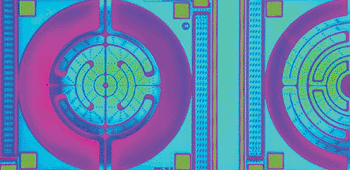New High-Sensitivity Breath Analyzer Enables Wide Range Multi-Biomarker Identification
By LabMedica International staff writers
Posted on 06 May 2013
Scientists and engineers have developed a gas-sensing technology that could enable multiple diseases and other conditions to be diagnosed and monitored using a single, highly sensitive breath analyzer.Posted on 06 May 2013
Thousands of chemical compounds are exhaled with every breath. The infrared emitter developed by Cambridge CMOS Sensors (CCMOSS; Cambridge, UK) is a low-power, low-cost device capable of identifying more than 35 biomarkers present in exhaled human breath in concentrations as low as 1 part per million. “Noninvasive breath analysis is an area of great potential for diagnosing and monitoring a wide range of medical conditions,” said Professor Florin Udrea of the Dept. of Engineering and CCMOSS’ CEO and cofounder; “Testing is easy and painless, and can be repeated as often as needed.”

Image: Microscope/Micrograph of MEMS micro-heating element with integrated CMOS electronic driver and temperature sensing circuits (Photo courtesy of Cambridge CMOS Sensors).
A number of breath analysis tests are currently in the R&D phase, most of which use mass spectrometry or lasers to analyze the breath for specific compounds. However, these tests can detect only a small range of compounds, so different devices are needed to detect different conditions. The CCMOSS technology differs in that it uses broadband infrared radiation to make the detection of a wide range of biomarkers possible in a single device. The miniature heaters, or microhotplates, can be heated from room temperature to 700 °C in a fraction of a second, a temperature high enough to emit infrared radiation and allow the sensing material to react with gas molecules.
Many gas molecules absorb infrared. The amount of radiation absorbed allows the gas to be identified and its concentration calculated - the basic principle behind, for example, the roadside breathalyzer test. CCMOSS’s technology, however, is far more sensitive - using broadband infrared, the gas sensor can detect wavelengths between 2 and 14 micronmeters, corresponding to a wide range of biomarkers. In order to detect different wavelengths, a filter is placed over the detector so that only infrared radiation of a particular wavelength can get through.
The company, a spinout from the University of Cambridge Department of Engineering, has been supported by seed funding from Cambridge Enterprise, the University’s commercialization arm. The CCMOSS technology is being developed for use in noninvasive medical analysis and other applications such as consumer electronics, industrial security, and automotive applications. It currently has a range of products available and is actively involved in R&D projects for next generation micro- and nanosensors.
Related Links:
University of Cambridge
Cambridge CMOS Sensors (CCMOSS)













